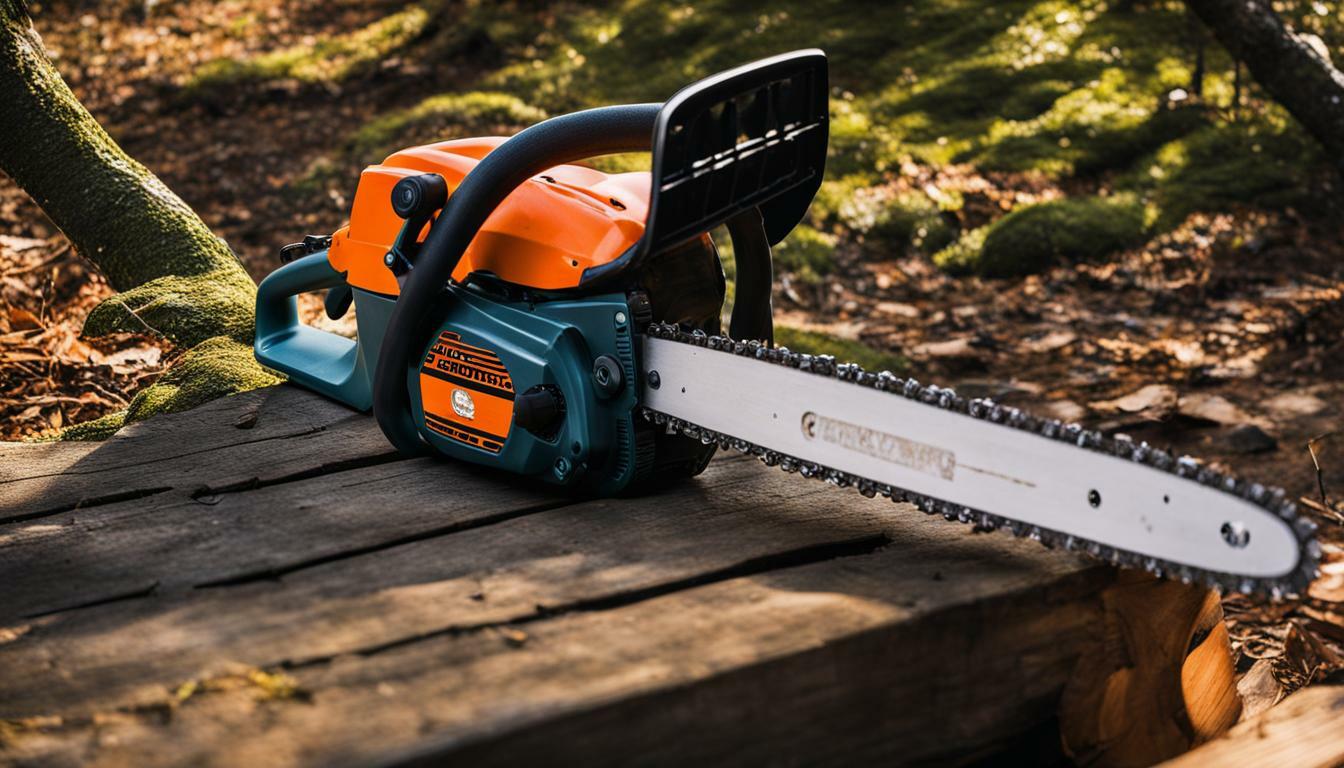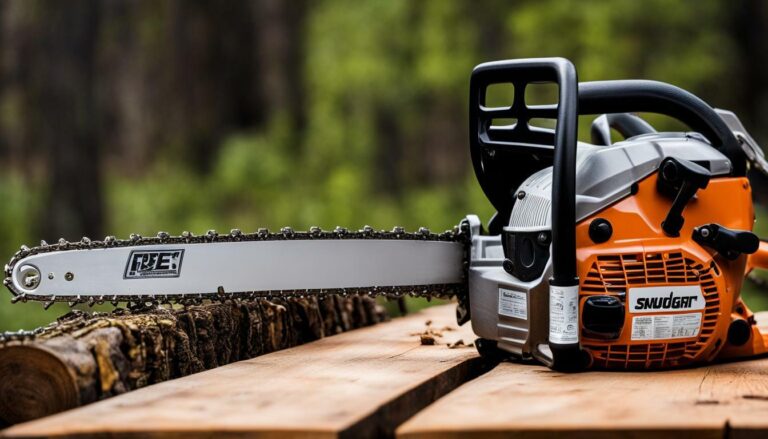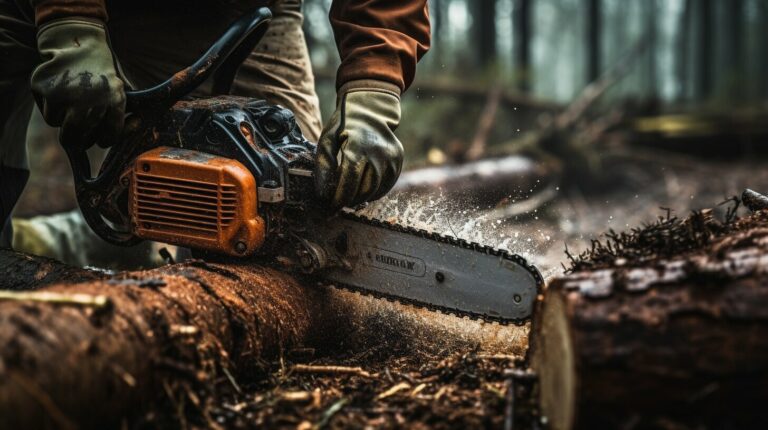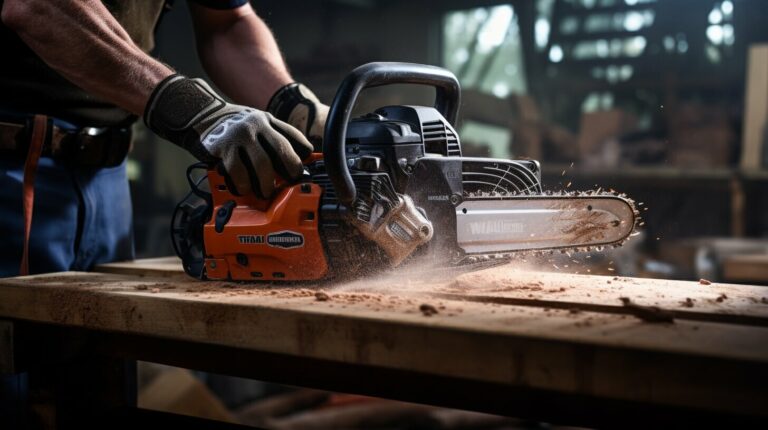Mastering the Art: Which Way Does a Chain Go on a Chainsaw?
If you’ve ever wondered which way does a chain go on a chainsaw, it’s crucial to understand the correct chain direction to ensure safe and efficient operation. Putting the chain on incorrectly can lead to various issues and potential dangers. To help you master this essential skill, we’ll discuss the proper chain placement on a chainsaw and provide step-by-step guidance on installing and maintaining your chainsaw chain.
Key Takeaways:
- Always ensure that the chain on your chainsaw moves clockwise when viewed from the right side.
- Incorrect chain placement can result in the chainsaw not cutting, damage to the drive sprocket, increased risk of kickback, and other potential hazards.
- Regular chainsaw maintenance, including using high-quality gas and oil, routine upkeep and checks, and correct chain sharpening, is essential for optimal performance.
- Sharpen the chainsaw chain using a file holder or a file jig/roller guide, and ensure the height of the rakers is slightly less than that of the cutters.
- Check the depth of the rakers with a depth gauge and file and round them off as needed.
Which Way Does a Chain Go on a Chainsaw?

When operating a chainsaw, it’s important to understand the proper way to install a chain. After all, the chain is the vital component that allows the chainsaw to cut through wood effectively. If you’ve ever wondered which way a chain goes on a chainsaw, you’re in the right place. In this blog post, we’ll explore which way does a chain go on a chainsaw, along with some essential tips to remember.
Before we dive into the specifics, it’s crucial to mention that chainsaws may have slightly different features, so it’s always best to consult the manufacturer’s instructions for your specific model. However, the general principles outlined here apply to the majority of chainsaws.
1. Proper Chain Orientation:
The chain on a chainsaw is designed to cut in one direction, so it’s crucial to install it correctly. The cutting teeth on the chain are positioned to face toward the front of the chainsaw, which is the direction of rotation. This means that when the chainsaw is used, the bottom of the cutting teeth should be facing forward. This ensures that the chain bites into the wood and cuts efficiently.
2. Chain Direction Indicator:
Most chainsaw chains have a small arrow or directional indicator stamped on them. This arrow indicates the correct orientation of the chain. When installing the chain, ensure the arrow points in the same direction as the front of the chainsaw. This simple visual cue can help ensure you install the chain correctly every time.
3. Tensioning the Chain:
Once you have installed the chain correctly, it’s crucial to ensure it is properly tensioned. A loose chain can be dangerous and may come off the guide bar during operation. On the other hand, an overtightened chain can lead to excessive wear and reduced performance. Refer to your chainsaw’s manual for the specific tensioning instructions, as different models may have different requirements.
4. Regular Maintenance:
Regular maintenance is essential to keep your chainsaw chain working at its best. This includes cleaning the chain regularly, sharpening the cutting teeth when needed, and lubricating the chain before each use. Regular maintenance will not only improve the performance of your chainsaw but also extend the chain’s lifespan.
5. Safety Precautions:
Operating a chainsaw can be hazardous, so taking proper safety precautions is crucial. Always wear protective gear like goggles, gloves, and ear protection. Familiarize yourself with your chainsaw’s safety features and ensure they are properly working. It’s also advisable to have a first aid kit nearby and to inform someone about your chainsaw use.
What is the difference between a gas and an electric chainsaw?
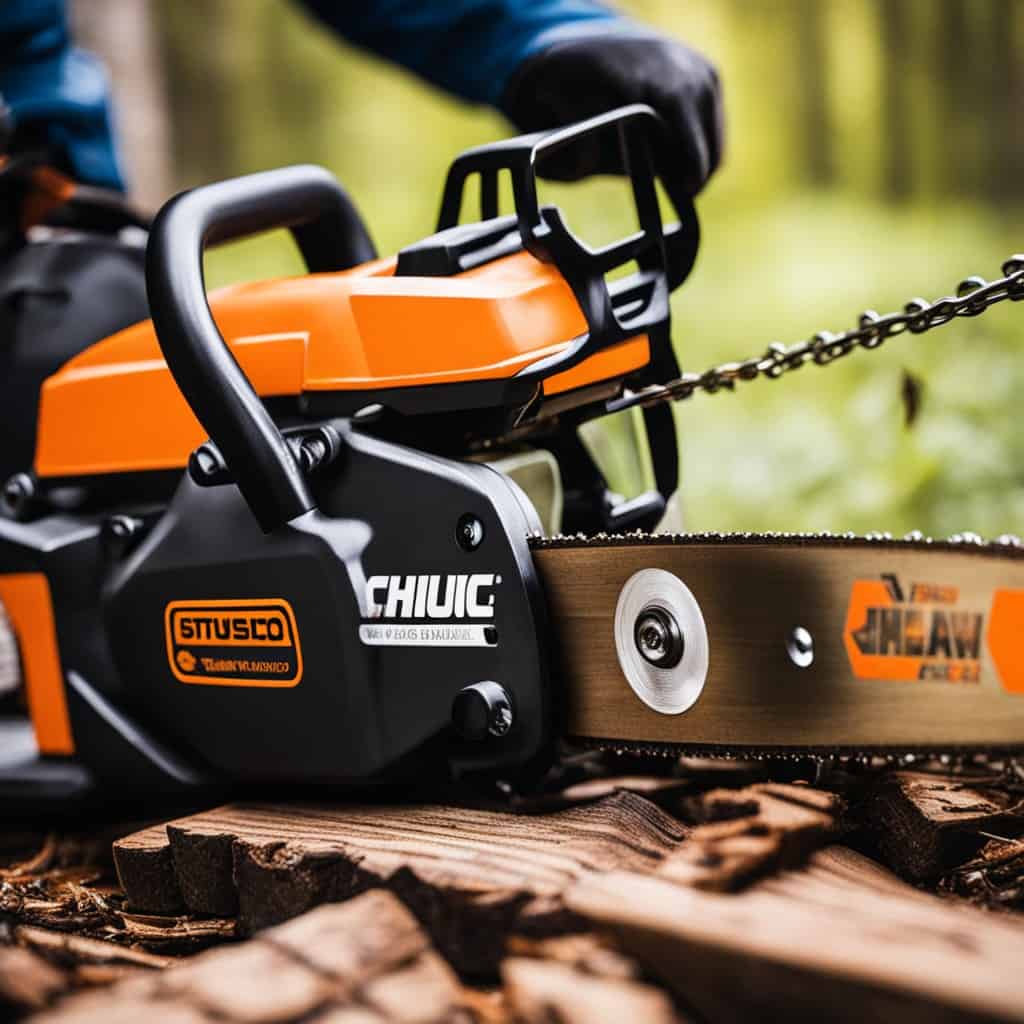
A chainsaw is a tool that is used for cutting through wood. There are two main types of chainsaws: gas and electric.
Gas chainsaws are the most common type of chainsaw. They are powered by gas and are typically more powerful than electric chainsaws. Gas chainsaws are great for cutting through large pieces of wood, and they are also portable, so you can take them wherever you go.
Electric chainsaws are not as common as gas chainsaws, but they are becoming more popular. Electric chainsaws are powered by electricity and are typically more lightweight and easier to use than gas chainsaws. Electric chainsaws are great for small projects and people who don’t want to deal with the hassle of gas.
Both gas and electric chainsaws have pros and cons, but ultimately, it comes down to personal preference. A gas chainsaw is the way to go if you need a powerful chainsaw for big projects. If you want a lightweight and easy-to-use chainsaw for small projects, an electric chainsaw is the way to go.
Can you recommend some safety tips for using a chainsaw?
Chainsaws are one of the most versatile and dangerous tools a person can use. They can be used for various tasks, from cutting down trees to trimming branches. While a chainsaw can be useful, it is also extremely dangerous. Every year, there are numerous accidents involving chainsaws, some of which result in serious injury or death.
Here are some safety tips to keep in mind when using a chainsaw:
1. Always wear proper safety gear. This includes gloves, eye protection, and hearing protection. It is also a good idea to wear long pants and closed-toe shoes.
2. Be aware of your surroundings. Make sure that there are no people or animals nearby that could be hurt if something went wrong.
3. Inspect your chainsaw before each use. Ensure the chain is properly installed and the saw is in good working condition.
4. Be careful when starting the chainsaw. Place the saw on the ground and ensure the chain is not in contact with anything before pulling the starter cord.
5. never put your hand near the chain while the chainsaw runs. If the chain comes into contact with your hand, it can cause serious injury.
6. When cutting, be aware of the direction of the chain. The chain spins towards the saw’s tip, so be careful not to cut yourself if the saw slips.
7. Keep the chainsaw blade sharp. A dull blade will cause the saw to bind, which can be dangerous.
8. Never use a chainsaw while under the influence of drugs or alcohol.
9. If you are not experienced in using a chainsaw, consider taking a class or hiring someone experienced to do the job.
Following these safety tips can help prevent serious injury or death when using a chainsaw.
Maintaining and Sharpening Your Chainsaw Chain
In addition to correctly installing the chainsaw chain, ongoing maintenance and sharpening are essential to ensure optimal performance and longevity of the chain and the chainsaw itself. Regular maintenance will not only extend the life of your chainsaw but also contribute to safer and more efficient cutting.
Chainsaw Maintenance
Proper chainsaw maintenance starts with using high-quality gas and oil. This ensures that your chainsaw’s engine runs smoothly and that the chain remains lubricated for optimal performance. Regular upkeep and checks are also vital, including inspecting the chain for any signs of damage, checking and tightening the various bolts and screws, and cleaning the air filter to prevent clogs.
Furthermore, the chainsaw’s chain will gradually become dull with use, reducing cutting efficiency and increasing the risk of kickback. Sharpening the chainsaw chain correctly is crucial to maintaining its cutting performance. You can sharpen the chain using a file holder or jig/roller guide to maintain the proper angle and depth when filing each cutter. It’s also important to check and adjust the depth of the rakers, ensuring they are slightly lower in height than the cutters to facilitate smooth cutting.
Proper Sharpening Technique
When sharpening the chainsaw chain, it’s recommended to work systematically and ensure consistency across all the cutters. Start by securing the chainsaw in a vice or using a chainsaw sharpening kit for added stability. Then, using a round file matched to the size of the chain’s cutters, file each cutter from the inside out, following the original angle of the cutter. Take care to maintain a consistent filing angle to avoid uneven cutting performance.
Additionally, it’s important to periodically assess the depth of the rakers using a depth gauge. If the rakers are too high, they can impede proper cutting, while the risk of kickback increases if they are too low. File and round off the rakers to achieve the correct depth, ensuring smooth and safe cutting with your chainsaw.
By following these maintenance and sharpening guidelines, you can keep your chainsaw in optimal condition, ensuring efficient cutting while reducing the risk of accidents. Always prioritize safety when working with a chainsaw, wearing appropriate protective gear, and following manufacturer instructions for proper usage and maintenance.
FAQ
Which way does the chain go on a chainsaw?
The chain on a chainsaw always goes clockwise if you look at it from the right side. It should move forward and away from you when you look down on the chainsaw from above while holding it.
What are the consequences of putting the chain on backward?
Putting the chain on backward can cause the chainsaw to not cut, damage the drive sprocket, increase the risk of kickback, burn the wood instead of cutting it, cause the chain to come off the bar easily, or even get the chain ripped off.
How do I put on a chainsaw chain correctly?
To put on a chainsaw chain correctly, the engine should be turned off, and the chain tensioning screw should be loosened. The clutch cover should be removed, and the chain and bar should be removed. The chain should be put onto the bar in the right direction, with the cutters pointing toward the bar’s tip. The bar should be reattached to the saw, the chain should be placed around the chain sprocket, and the cover should be put back on and tightened. The chain tensioner should be adjusted to tighten the chain so it doesn’t sag below the bar.
What is the importance of chainsaw maintenance?
Chainsaw maintenance is essential to ensure optimal performance and longevity. This includes using good quality gas and oil, regular upkeep and checks, and sharpening the chainsaw chain correctly.
How do I sharpen the chainsaw chain correctly?
Sharpening can be done using a file holder or a file jig/roller guide. The height of the rakers should be slightly less than that of the cutters. Checking the depth of the rakers with a depth gauge and filing and rounding them off as needed is also necessary.
